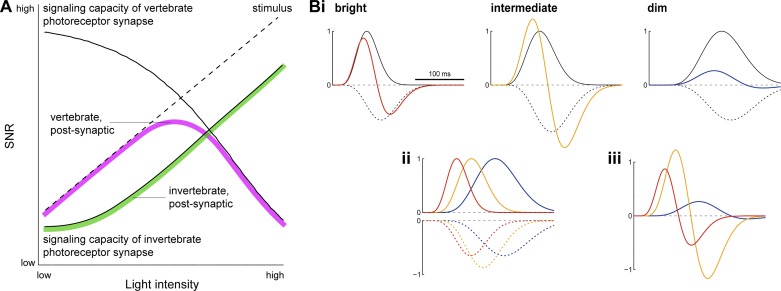Fig. 6.
A: hypothetical model of light level-dependent changes in SNR in the vertebrate retina. Schematic shows the presumed bounds to SNR set by the visual signal and photoreceptor synapses of vertebrates and invertebrates. In all organisms, SNR in the retina (green, magenta) is constrained by SNR of the visual input (dashed line) and SNR in the neurons that receive and transmit this input (photoreceptors; solid lines). In the eye of invertebrates, with increasing light, SNR of the visual input and SNR of the photoreceptor synaptic output grow in parallel, because increasing photon flux increases the rate of synaptic vesicle release (assuming Poisson noise). In vertebrates, the expected pattern is different, because increasing photon flux decreases the rate of synaptic vesicle release. In dim light, stimulus SNR limits retinal SNR, whereas in bright light, due to the low rate of synaptic vesicle release, synaptic SNR limits retinal SNR. We postulate that the cone synapse limits SNR in postsynaptic retinal neurons, causing retinal SNR in vertebrates to peak at an intermediate light level, consistent with the results. B: a hypothetical model (see methods for details) recapitulates observed changes in ganglion cell filter time course across light-adapted states. i, Opponent monophasic filters with different time course and amplitude, representing interacting excitatory (solid black) and inhibitory signals (dashed, black) and combined by subtraction, approximate the observed changes in ganglion cell filter characteristics at different light levels (see Figs. 2B, 2C, and 4D: bright, red; intermediate, yellow; dim, blue). ii, Overlay of the excitatory (top) and inhibitory (bottom) filters in bright, intermediate, and dim light shown in i. iii, Overlay of the resultant filters in bright, intermediate, and dim light shown in i. Similar to the measured ganglion cell filter values (Fig. 5, B and C), the temporal delay between the peak of the combined (center; colors) filter and the peak of the opponent (surround; black dashed) filter is approximately constant at ~35 ms. Amplitude of the resultant filter at each light level was adjusted with an overall gain factor to match the measured filters.

